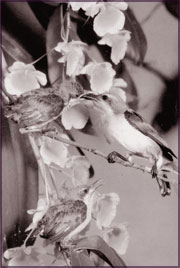Home in a cobweb
Ingenuity of sunbirds:
by K.G.H. Munidasa
Among our resident birds the Purple Sunbird has earned a place for
itself by the wonderful ingenuity it displays in the selection of
nesting sites.
Not only that it is found to build its pear-shaped nests of fibre in
the most unusual locations, but also to spend a blissful family life in
them.
In my notebook there is a record of a nest having been placed in a
bird-lover's trouser pocket, by a pair of sunbirds on the hunt for
nesting sites. Of course, the trouser was hung on a clothesline in his
verandah, to dry after use.
On another occasion a pair of sunbirds successfully raised to
maturity a brood of chicks in a nest built among the folds of a
threadbare face towel I had left in a coir line outside my storeroom. A
sunbird's nest I once examined at the invitation of a friend was in his
bedroom in close proximity to a twin bed.
Nest in cobwebs
The hen sunbird had come through the window and built the nest on a
clothesline, while the occupants of the house watched in amazement.
|

Three Sunbirds |
In the dry zone one would often find the Purple Sunbirds nesting in
masses of cobwebs built by the sociable spider known to science as
Stegodyphus sarasinorum, in low thorn bushes.
Here the hen would simply presse a hole on to the side of the cobweb
mass and lay her clutch on a scanty lining of vegetable down. In
February 1968 I placed on record with the Bombay Natural History Society
the following case, which I presumed was an all-time achievement for a
pair of wild birds: We were then living at an off-the beaten track
village in the Eastern Province.
One afternoon, I noticed a female sunbird clinging on to a night gown
left on a GI wire clothesline in the backyard. After meddling with the
fabric between the folds of the gown, she flew away.
A closer look revealed that she was apparently trying to build a nest
and I found a small collection of cobwebs with three empty spider egg
cocoons there. It was late that day to make any further observations,
and in the night my wife removed the gown.
The following morning, before leaving for work, I placed an old
canvas (type commonly used in deck chairs) on the clothesline and
arranged it in such a way to leave two well-defined folds. In between
the folds I made a fairly deep pocket using office pins.
Building commences
When I returned home in the evening I found the sunbird had started a
nest in the 'pocket', using her own building materials. She stuffed the
inside profusely with cotton collected from a Kapok tree growing at the
edge of the garden.
A week later two speckled eggs were laid in the chamber and the hen
started sitting. The nest was in the centre of the wire, hardly two feet
off the ground. Late one afternoon strong wind blew the canvas to the
far end of the wire, but without any ill-effects. I dragged it back into
position again. The brooding hen was quite tame by then and did not heed
such disturbances.
A fortnight later the eggs were successfully hatched, when the cock
sunbird started paying frequent visits on the family. Before this he
hardly came near the nest and spent his time on one of two selected
lookouts, 25-30 yards from the site, which provided an unobstructed view
of the nest site.
However, he never failed to send out a warning to the hen in nest
whenever anyone passed close to her brooding chamber. Nevertheless, the
hen took little or no notice of these warning signals.
Once I accidentally brushed against the nest and she was not alarmed.
But if I ever looked at her hard she got excited and nervy. At night I
occasionally flashed my torch-light to find her sitting very close with
her beak drawn in.
After the brood was a few days old the cock played a prominent role
in fending for them and appeared to be very much attached to the family.
Every time he fed the young he removed a beak-full of their droppings
for disposal.
By about the fifth day the young started to fledge and were
completely so about the fourteenth day after their birth.
They were coloured exactly like their mother, perhaps a little darker
in the upper parts. But the yellow on the chin and upper breast was
brighter in comparison.
Leaving home
One sunny afternoon, about a fortnight later, on impulse I took one
of the chicks out but it soon freed itself from my grip and flew away.
It was with much difficulty that I recaptured it and put it back in
the nest. On its own the same chick left the nest once more and I had to
run all over the garden to get it.
Early the following morning the same chick had left the nest without
our knowledge and when my nephew walked up to investigate the other
chick too, left the nest chamber and winged away to the nearby shrub
jungle, followed by the parent birds.
During the next couple of days the family stayed in and around our
home garden and the chirping of the young could be heard off and on
throughout the day. |
